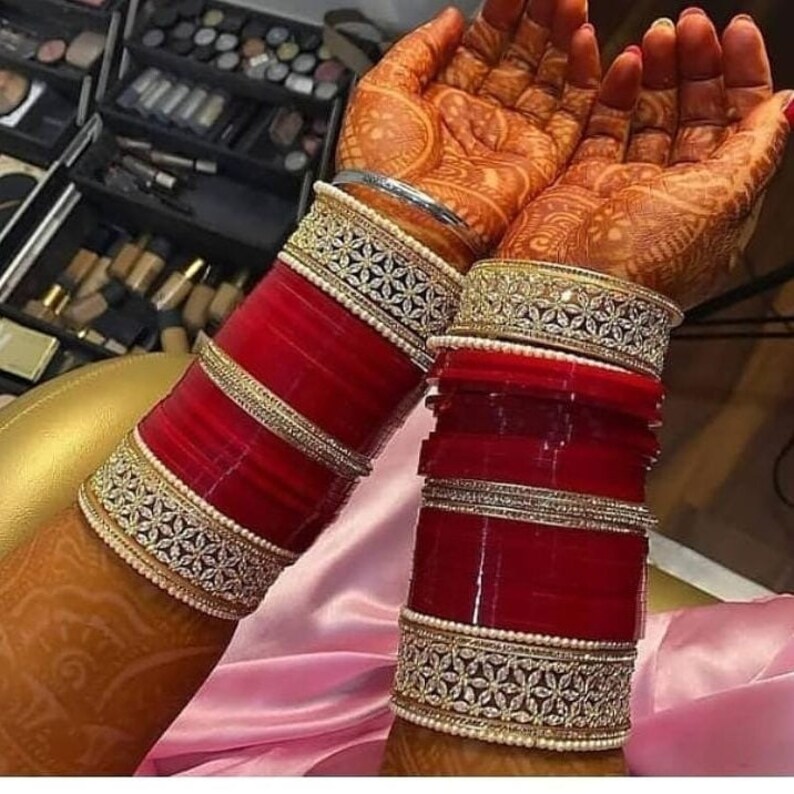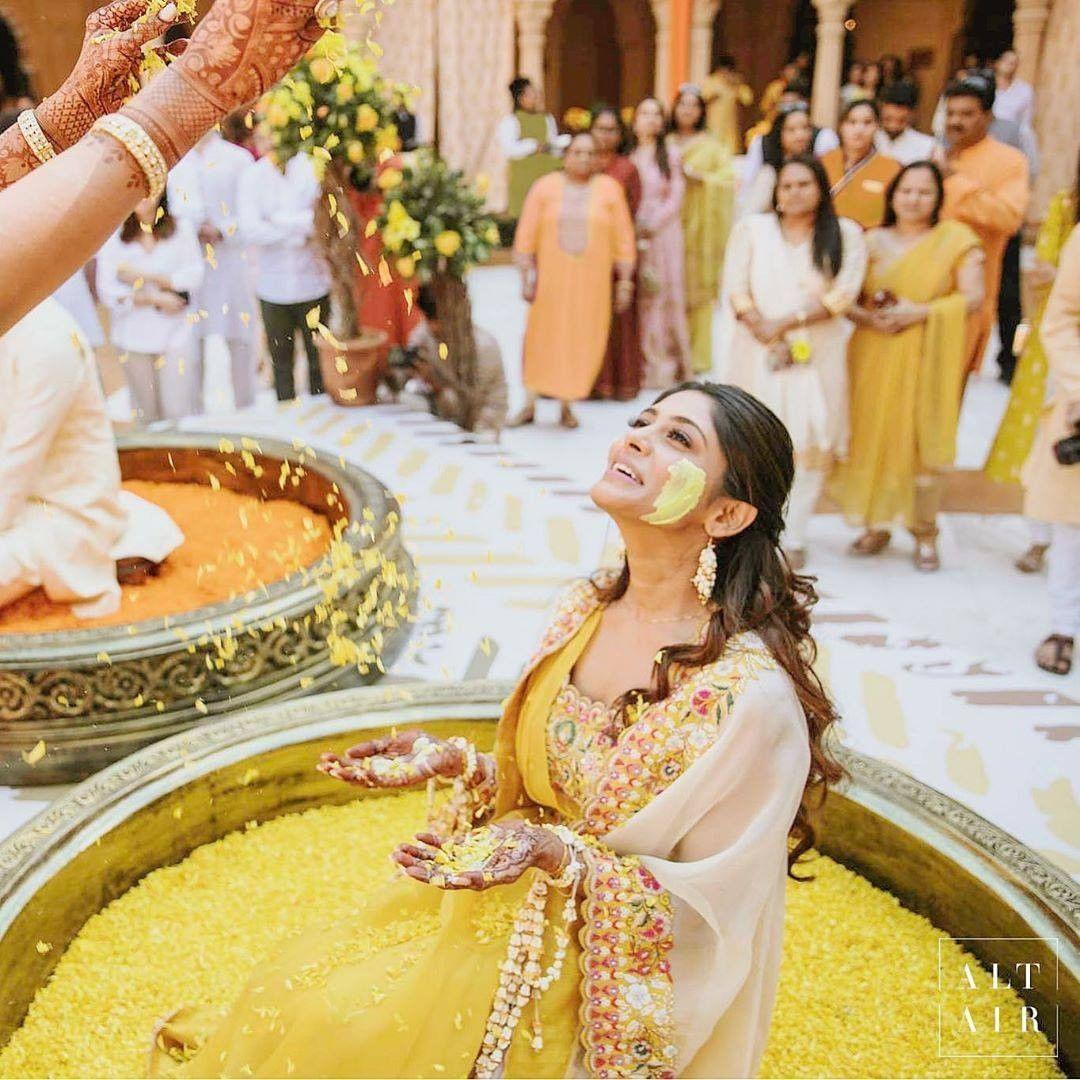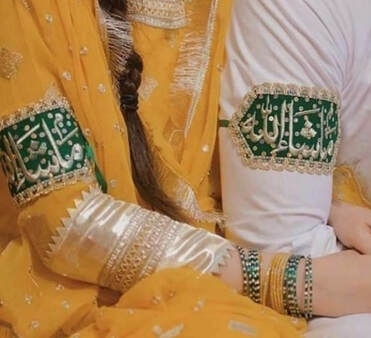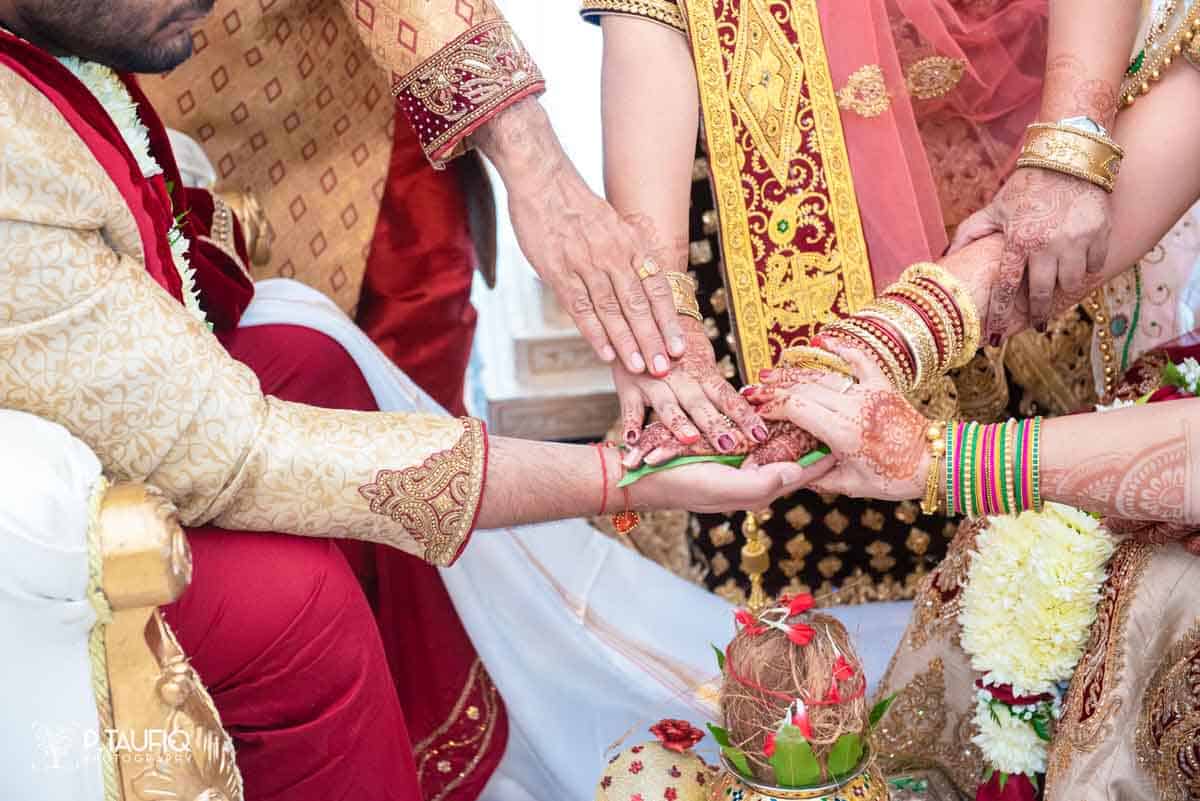Pakistani Indian Wedding Ceremonies
Pakistani Indian Wedding Ceremonies
Pakistani and Indian weddings are known for their vibrant colors, intricate designs, and beautiful dresses. The wedding attire is an important aspect of these weddings, with both the bride and groom wearing traditional outfits that have been passed down through generations.
For the bride, the traditional outfit is a lehenga, a long skirt paired with a blouse, and a dupatta (a long scarf). The lehenga is typically embroidered with intricate designs and embellishments and is often made of silk or other luxurious fabrics. The dupatta is also intricately designed and draped over the bride's head and shoulders.
The lehenga is available in a variety of styles, including the traditional A-line, the mermaid silhouette, and the fishtail. The A-line lehenga is fitted at the waist and flares out at the bottom, creating a flowing and elegant look. The mermaid silhouette is fitted at the waist and hips and then flares out at the bottom, giving the appearance of a mermaid's tail. The fishtail lehenga is similar to the mermaid silhouette, but is even more fitted and has a more dramatic flare at the bottom.
In addition to the different styles of lehenga, there are also many different types of embroidery and embellishments that are used to decorate the outfit. The most common type of embroidery is zari, which is done using gold or silver thread. Zari embroidery is often used to create intricate floral designs or to create borders along the hem of the lehenga. Another popular type of embroidery is kamdani, which uses tiny beads and sequins to create delicate patterns.
The color of the lehenga is also an important consideration. In Pakistani and Indian cultures, certain colors are associated with different emotions and occasions. For example, red is a traditional color for weddings, as it symbolizes love and passion. Other popular colors for wedding lehengas include pink, orange, and gold.
For the groom, the traditional outfit is a sherwani, a long jacket worn over a kurta (a long shirt), and pajama (loose pants). The sherwani is often embroidered with gold or silver thread and is worn with a turban on the head. The sherwani is available in a variety of styles, including the traditional long jacket, the short jacket, and the achkan. The long jacket extends to the knees and is often worn with churidar (tight-fitting pants) instead of pajamas. The short jacket is waist-length and is paired with pajamas or churidar. The achkan is a long, fitted jacket that extends to the ankles and is worn with a churidar.
In addition to the embroidery and embellishments on the sherwani, the color of the outfit is also important. The most popular color for sherwanis is blue, as it symbolizes wisdom and confidence. Other popular colors include red, green, and gold.
In addition to the traditional outfits, many Pakistani and Indian brides and grooms also choose to wear Western-style wedding dresses and suits. This can be a blend of both Western and Eastern styles or a completely Western-style outfit. For example, a bride may choose to wear a white wedding gown with a red lehenga underneath, or a groom may wear a black tuxedo with a gold sherwani. This allows the couple to incorporate their own personal style into their wedding attire, while still honoring their cultural traditions.
Pakistani Vs Indian weddings
As we can see, both cultures have some of their wedding traditions that are totally unique. This article will talk about why these differences occur and what it means for those planning an event or attending one!
First off, let’s discuss how weddings in India and Pakistan differ. In terms of decorations, there is no difference. Both use flowers, rice, and tandoori dishes to add flavor to the food.
But what kind of clothes people wear does vary from country to country. For example, Indians typically dress up more formally than Americans do. And during Hindu ceremonies, men usually don’t cut their hair until months later.
In Muslim countries like Pakistan, women cannot show any skin above the knees and must be fully covered with a head-to-toe veil.
Wedding Ceremonies In Pakistani and Indian culture
What culture’s wedding tradition seems weird to others may actually be very popular at home. For instance, just because Westerners view wearing white after Easter as too gaudy doesn’t mean Christians in Italy don’t.
There are many traditional wedding ceremonies in Pakistani and Indian culture, including the following:
The Roka or Engagement: A pre-wedding ceremony in which the families of the bride and groom come together to announce and celebrate the engagement.
The Roka or Engagement

The Roka is a traditional pre-wedding ceremony in Pakistani and Indian culture. It is a formal ceremony in which the families of the bride and groom come together to announce and celebrate the engagement.
During the Roka ceremony, the families exchange gifts and sweets, and the couple exchange rings. The rings are placed on the couple's right hands, as the right hand is considered auspicious in Pakistani and Indian culture. The couple may also exchange garlands or perform other rituals to symbolize their commitment to each other.
The Roka ceremony is often a joyous and festive occasion, with music and dancing. It is an important step in the wedding process, as it signifies the couple's intention to marry and marks the beginning of the wedding preparations.
In some Pakistani and Indian communities, the Roka ceremony is combined with the Mehndi ceremony, in which the bride's hands and feet are decorated with henna. This is a joyful and festive occasion, with music and dancing, and is a great way for the families to come together and celebrate the upcoming wedding.
The Mayun: A pre-wedding ceremony in which the bride-to-be is showered with blessings and gifts.
The Mayun

Mayun is a traditional pre-wedding ceremony in Pakistani and Indian culture, during which the bride-to-be is showered with blessings and gifts. For this occasion, the bride typically wears a simple but elegant outfit, often a saree or a lengha choli.
The saree is a traditional Indian garment, consisting of a long piece of cloth that is draped around the body in a specific manner. It is typically worn with a blouse and a petticoat (an underskirt) and is accompanied by a dupatta (a long scarf). The saree is available in a variety of colors, fabrics, and styles, and can be embellished with embroidery, beading, or other decorations.
The lengha choli is a traditional Pakistani garment, consisting of a long skirt (the lengha), a blouse (the choli), and a dupatta. The lengha is fitted at the waist and flares out at the bottom, creating a flowing and elegant look. The choli is a fitted, cropped blouse that is worn over the lengha. The dupatta is draped over the head and shoulders, completing the outfit. Like the saree, the lengha choli is available in a variety of colors, fabrics, and styles, and can be embellished with embroidery, beading, or other decorations.
For the Mayun ceremony, the bride typically wears a simple and elegant saree or lengha choli in a pastel color, such as light pink or light blue. The outfit is often adorned with minimal embroidery or embellishments, allowing the bride's natural beauty to shine through. The dupatta is typically draped over the bride's head, covering her hair and completing the traditional look.
During the Mayun ceremony, the bride is surrounded by her female family members and friends, who shower her with blessings and gifts. She is also adorned with traditional henna designs on her hands and feet, which are said to bring good luck and happiness to the marriage. The Mayun ceremony is a special and joyous occasion that marks the beginning of the wedding celebrations.
The Mehndi: A pre-wedding ceremony in which the bride's hands and feet are decorated with henna.
The Mehndi / Mehendi

Mehendi also spelled Mehndi, is a traditional pre-wedding ceremony in Pakistani and Indian culture. It is a ceremony in which the bride's hands and feet are decorated with henna.
Henna is a natural dye made from the leaves of the henna plant. It is applied to the skin in intricate designs and is said to bring good luck and happiness to the marriage. The designs can be simple or complex, and are often symbolic or have special meaning. For example, some designs may include the initials of the bride and groom or may incorporate traditional symbols of love and happiness.
The Mehndi ceremony is often a joyful and festive occasion, with music and dancing. The bride is surrounded by her female family members and friends, who help apply the henna and celebrate with her. The Mehndi ceremony is an important part of the wedding preparations and is a special and joyous occasion for the bride and her loved ones.
The Dholki or Sangeet: A pre-wedding ceremony in which the families of the bride and groom come together to sing and dance in celebration of the upcoming wedding.
The Dholki or Sangeet
A dholki is a type of drum that is commonly used in traditional Indian and Pakistani music. It is a barrel-shaped drum with a small, open mouth on one end, and it is typically played with a pair of wooden sticks. The dholki is often used to provide rhythmic accompaniment for folk songs and is a popular instrument at weddings and other celebrations.
Sangeet is a term used in Indian and Pakistani culture to refer to a musical performance, typically one that is part of a larger celebration such as a wedding. In a traditional sangeet, musicians will perform a variety of songs and instrumental pieces, and members of the audience may also join in by singing or playing instruments. Sangeet can also refer to the study or practice of music in general. It is derived from the Sanskrit word "Sangeeta," which means "related to music."

The Chuda: A pre-wedding ceremony in which the bride's hands and wrists are adorned with red and white bangles.
The Chuda
Chuda is a traditional pre-wedding ceremony in some Pakistani and Indian communities. It is also known as the Chooda or Chudya ceremony.
During the Chuda ceremony, the bride's hands and wrists are adorned with red and white bangles, known as chuda. The chuda are made of ivory or other materials and are worn in sets of 21 or 40. They are typically worn for 40 days after the wedding and are then removed by the bride's mother-in-law.
The Chuda ceremony is typically a family affair, with only female family members and friends in attendance. The bride's mother, sister, or other close female relative helps her put on the chuda and offers blessings and gifts. The chuda is believed to bring good luck and happiness to the marriage and is an important part of the wedding preparations.
In some Pakistani and Indian communities, the Chuda ceremony is combined with the Mehndi ceremony, in which the bride's hands and feet are decorated with henna. This is a joyful and festive occasion, with music and dancing, and is a great way for the families to come together and celebrate the upcoming wedding.

The Manjha or Haldi: A pre-wedding ceremony in which the bride and groom are smeared with a paste made of turmeric and other herbs.
The Manjha or Haldi
There is a pre-wedding ceremony in some Indian and Pakistani cultures called the Haldi ceremony, in which a paste made of turmeric is applied to the skin of the bride and groom as a form of blessing and purification. However, this ceremony does not involve the use of manjha.

The Nikkah or Baraat

The Nikkah or Baraat: The groom's wedding procession, in which he is accompanied by family members and friends as he makes his way to the wedding venue. Nikkah is a traditional wedding ceremony in Pakistani and Indian culture, as well as in many other Muslim communities around the world. It is a religious ceremony in which the marriage contract is signed and the bride and groom become husband and wife.
The Nikkah ceremony is typically performed by a religious official, such as an imam or a qadi (a Muslim judge). The ceremony is conducted in Arabic and is based on the principles of Islamic law. The bride and groom must each have a witness present, and the marriage contract must be signed by both parties.
The Nikkah ceremony is a simple and straightforward affair and does not involve any elaborate rituals or customs. However, it is an important and sacred event, as it signifies the beginning of the couple's new life together as husband and wife. After the Nikkah ceremony, the couple is considered to be legally married according to Islamic law.
In some Pakistani and Indian communities, the Nikkah ceremony is combined with other traditional wedding ceremonies, such as the Baraat (the groom's wedding procession) and the Walima (the wedding reception). This allows the couple to celebrate their marriage with their family and friends, while still honoring their religious beliefs and traditions.
Vidai or Rukhsati

Vidai or Rukhsati: Rukhsati, also spelled Rukhsat, is a traditional wedding ceremony in Pakistani and Indian culture. It is the final ceremony in a series of wedding rituals and marks the end of the wedding celebrations.
During the Rukhsati ceremony, the bride says goodbye to her family and leaves for her new home with the groom. She is typically accompanied by her female family members and friends, who shower her with blessings and gifts as she departs. The groom's family also offers gifts and blessings and may escort the bride to her new home.
The Rukhsati ceremony is an emotional and poignant occasion, as the bride leaves behind her childhood home and begins her new life as a married woman. It is a time of both joy and sadness, as the bride and her family bid each other farewell and look forward to the future.
The Valeema ceremony

Valeema also spelled Walima: is a traditional wedding ceremony in Pakistani and Indian culture, as well as in many other Muslim communities around the world. It is the wedding reception and marks the end of the wedding celebrations.
During the Valeema ceremony, the bride and groom are seated on a stage and are surrounded by their family and friends. A feast is served, and the couple is showered with blessings and gifts. Music and dancing are also typically part of the celebrations, and the couple may cut a wedding cake or perform other traditions to mark the occasion.
The Valeema ceremony is a joyous and festive occasion and is an important part of wedding celebrations. It is a time for the couple to celebrate their marriage with their loved ones, and to enjoy food, music, and dancing. It is also an opportunity for the families to come together and celebrate the union of the bride and groom.
The Arsi-mushaf
The Arsi-mushaf: is often used in Pakistani and Indian weddings, as well as in weddings in other Muslim communities. It is often placed on a special table or altar during the wedding ceremony and may be opened to a specific chapter or verse that is considered to be particularly meaningful or auspicious. The couple may also recite prayers from the Arsi-mushaf as part of their wedding vows, and may ask for blessings and guidance from God.

Imam Zamin Ceremony

Imam Zamin Ceremony: In Pakistani and Indian culture, there is a tradition known as "Imam Zamin" in which coins are wrapped in a cloth and tied around the right upper arm for good luck and protection during weddings, travel, sickness, and new ventures. This tradition is especially popular among Shia Muslims, and is often associated with the engagement ceremony, which is known as "Imam Zamin ki Rasm" or "In Pakistani and Indian culture, there is a tradition known as "Imam Zamin" in which coins are wrapped in a cloth and tied around the right upper arm for good luck and protection during weddings, travel, sickness, and new ventures. This tradition is especially popular among Shia Muslims, and is often associated with the engagement ceremony, which is known as "Imam Zamin ki Rasm" or "Imam Zamin ki Ceremony."
The tradition of Imam Zamin is believed to have originated during the rule of Mamun al Rashid when pilgrims visiting the shrines of Karbala needed a personal guarantee from Imam Raza in order to enter. The Imam gave this guarantee to everyone, establishing his name as Imam Zamin, the Imam of guarantees. Mamun also ordered the state mint to engrave coins with Imam Raza's name, and these coins were kept on a person's body as a powerful symbol against calamities.
Today, many people still follow the tradition of Imam Zamin and will tie coins to their upper arm before embarking on a journey or important task. They will also message their loved ones with the phrase "Imam Zamin ki zamanat main Diya," which means "I have given the guarantee of Imam Zamin." Once they reach their destination safely, they will give the coin away as a charity in the name of the Imam. The tradition is also sometimes used to bring good luck and protection to sick people, by tying the coins to their arm.."
The tradition of Imam Zamin is believed to have originated during the rule of Mamun al Rashid when pilgrims visiting the shrines of Karbala needed a personal guarantee from Imam Raza in order to enter. The Imam gave this guarantee to everyone, establishing his name as Imam Zamin, the Imam of guarantees. Mamun also ordered the state mint to engrave coins with Imam Raza's name, and these coins were kept on a person's body as a powerful symbol against calamities.
Today, many people still follow the tradition of Imam Zamin and will tie coins to their upper arm before embarking on a journey or important task. They will also message their loved ones with the phrase "Imam Zamin ki zamanat main Diya," which means "I have given the guarantee of Imam Zamin." Once they reach their destination safely, they will give the coin away as a charity in the name of the Imam. The tradition is also sometimes used to bring good luck and protection to sick people, by tying the coins to their arms.
Joota Chupai
Joota Chupai: Joota Chupai is a traditional wedding game that is played in Pakistani and Indian culture. It is a fun and playful way for the bride and groom to celebrate their marriage and is often enjoyed by guests and family members as well.
During the Joota Chupai game, the groom's shoes are hidden by the bride's family and friends. The groom must then search for his shoes and may have to perform various tasks or challenges in order to find them. This can be a fun and playful way for the groom to show his love and devotion to the bride, and can also be a way for the bride's family and friends to have some fun and enjoy the wedding celebrations.
Once the groom has found his shoes, the bride's family and friends may ask for a reward or a gift in exchange for the shoes. This can be anything from money to sweets and is often a source of playful negotiation and banter. The Joota Chupai game is a fun and lighthearted way to celebrate marriage and is a popular tradition at many Pakistani and Indian weddings.

The Jaimala: A ceremony in which the bride and groom exchange garlands, symbolizing their acceptance of each other.
The Jaimala

Jaimala is a Hindu wedding ritual in which the bride and groom exchange garlands of flowers as a symbol of their acceptance of each other. The word "Jai mala" comes from the Hindi language and is made up of two words: "Jai," which means "victory," and "mala," which means "garland." This ritual is typically performed early in the wedding ceremony after the bride and groom have exchanged their vows. It is a joyful and festive moment in the ceremony and is often accompanied by music and dancing.
The Kanyadaan

The Kanyadaan: A ceremony in which the bride's father gives her away to the groom, symbolizing the transfer of parental responsibility.
Kanyadaan is a Hindu wedding ritual in which the father of the bride gives away his daughter to the groom. The word "kanyadaan" comes from the Sanskrit language and is made up of two words: "Kanya," which means "daughter," and "daan," which means "to give." This ritual is considered one of the most important in the Hindu wedding ceremony, as it symbolizes the father's blessing and acceptance of the union. It is also seen as a selfless act, in which the father is giving up something precious and dear to him for the happiness and well-being of his daughter.
The Pheras
The Pheras: A ceremony in which the bride and groom walk around a sacred fire four times, symbolizing the four pillars of a Hindu marriage.
Pheras, also spelled "pheras," is a Hindu wedding ritual in which the bride and groom take four rounds around a sacred fire, known as the Agni. The word "pheras" comes from the Sanskrit language and is derived from the word "Pravesh," which means "to enter." In this ritual, the bride and groom walk around the Agni together, each taking one step for every four steps taken by the other. As they walk, they recite mantras and make offerings to the fire, asking for blessings and guidance from the gods. The pheras symbolize the couple's commitment to each other and to their new life together.
Comments
Post a Comment